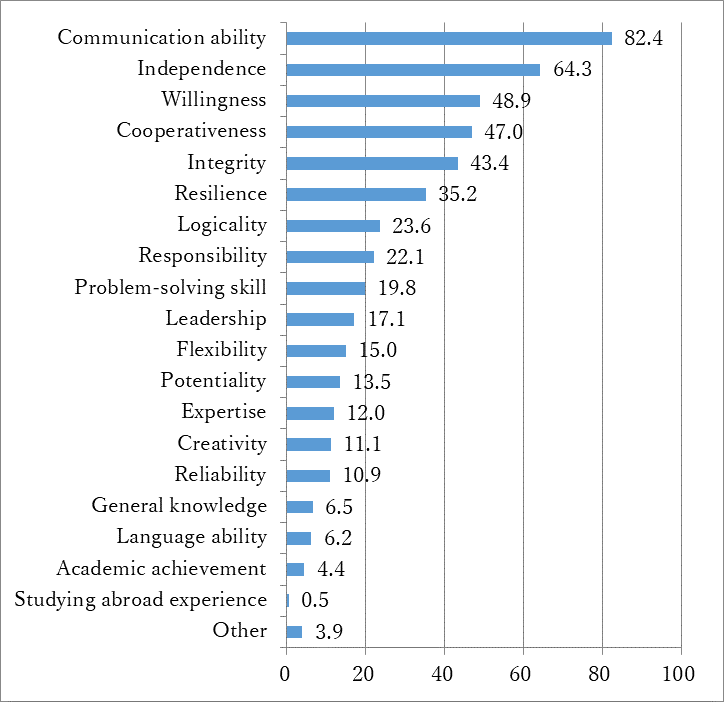Jobs & Careers in Japan
Employment in Japan
- HOME
- Jobs & Careers in Japan
- Employment in Japan
- Chapter 2. Job Hunting in Japan
Job hunting in Japan is very unique. You can hardly find a similar style of job hunting in any other country. Japanese companies recruit international students using the same quota and recruiting process as Japanese students. In other words, foreign students must compete with their Japanese counterparts for positions. In many cases, recruitment activities for foreign-affiliated companies in Japan are almost the same as those for Japanese companies. Therefore, in Japan, you must find a job under the domestic rules, regardless of whether you are applying to a Japanese or foreign-affiliated company.
Characteristics of Job Hunting in Japan
Bulk Hiring of Recent Graduates
The term “new graduate hiring” refers to hiring for people who have graduated from universities, graduate schools, or specialized training colleges and are starting work for the first time. This Japanese way of bulk hiring or “Shinsotsu-saiyo,” is quite unique. Companies want to recruit students who anticipate graduating in the following years, while they are still in school.
Starting Work in April
While September enrollment is the norm in many countries around the world, Japanese universities and specialized training colleges usually enroll in April and graduate in March. Therefore, in Japan, students who graduate in March will enter companies and start working on April 1, the first day of the following month.
Job Hunting Schedule
Many companies in Japan follow the same recruiting schedule. In addition, job hunting in Japan starts earlier than in many other countries. As of 2024, job hunting starts on March 1 every year by students who belong to the year prior to the final grade, including the third year of their bachelor's course, first year of their master's course, or second year of their PhD course respectively. The recruiting season lasts rather long and comes to an end four months later in the middle of June.
Recruitment Examinations
Many Japanese companies require students to take written exams in mathematics, Japanese, English, etc. They also often require a profile-sheet with a statement written in Japanese. For interviews, a minimum of three interviews of various types will be conducted at each company.
Hiring Criteria for Japanese Companies
Overseas and Japanese companies tend to hire their staff according to different hiring standards. Many overseas companies have introduced a “merit-based pay system” in which promotions and salary increases are based on a person's ability, work results, and performance, and they look for people who can make an immediate impact upon hiring. In such a selection process, the student's major at their university, as well as expertise and skills obtained during internships, etc. can make the difference between whether they are chosen for the position or not.
Meanwhile, as Japanese companies are accustomed to taking the time to provide employees with training necessary for their job, they tend to recruit promising students with good qualifications, who are likely to contribute to the company in the long-run. The chart below shows data based on employers' responses regarding key characteristics they look for when recruiting potential employees. Japanese companies regard characteristics such as potential communication ability, independence and cooperativeness as more important than academic scores, expertise in a certain field, and foreign language ability.

Source: Japan Business Federation “Questionnaire Survey on New Graduate Recruitment in 2018”
Potentiality-hiring
“Potentiality” originally indicates a capacity for development and future success. “Potentiality-hiring” is a way of recruiting by attaching greater value to an applicant's potential capability and future possibility of being successful, even if they may not be qualified in terms of skills and knowledge to fully contribute to the company at that particular moment. Japanese companies tend to hire people who are expected to be active in the future, rather than people who can be immediately effective, because they have a solid training system in place after joining the company.
Employment System of Japanese Companies
Japanese companies mainly conform to membership-type employment. This kind of employment does not specify any job category, work place or working hours and requires employees to be flexible so that they can deal with various kinds of tasks. The main feature of the system is to evaluate the ability to handle all duties as a generalist.
These companies hire a number of employees through a unified recruiting campaign every year, then let them get a sense of the company as well as acquire necessary knowledge during the initial “on-the-job training” period along with various training sessions for employees to gain further knowledge and skills. Because the job category and place of work are not specified, a company can reassign an employee based on the company's circumstances. As a result, an employee may not be able to be placed in their position or location of choice. This kind of working style is recorded as “Sogo-shoku” or “main career track” on recruitment campaign documents.
Among overseas countries, job-type employment is mainstream. Job-type employment is a form of employment in which the duties and work location are limited. It is characterized by clear job requirements and primarily evaluates the specialist's ability to perform the job. Continued employment and benefits depend on the duration of work and ability to perform. Companies can secure highly specialized and talented workers, but because they contract with workers within a specific job scope, if the job is no longer needed due to changes in the company's business conditions or policies, the contract may be terminated without reassignment, meaning the worker is at risk of losing their job.
To Chapter 3. Job Hunting Schedule
(Supervised by Manabu Kubota, Visiting Researcher of JASSO)
Reference
